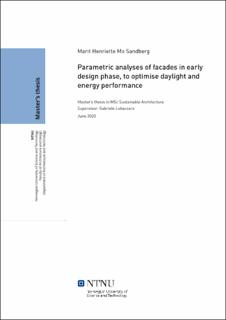| dc.contributor.advisor | Lobaccaro, Gabriele | |
| dc.contributor.author | Sandberg, Marit Henriette Mo | |
| dc.date.accessioned | 2020-07-25T16:00:46Z | |
| dc.date.available | 2020-07-25T16:00:46Z | |
| dc.date.issued | 2020 | |
| dc.identifier.uri | https://hdl.handle.net/11250/2670226 | |
| dc.description.abstract | I 2030 vil det være 6 millioner mennesker i Norge. Populasjonsveksten vil hovedsakelig forgå i de store byene. For å kunne nå målene fra Paris-avtalen og få lavutslippsbyer, må planleggingen av ekspansjonen av byene inneholde mange aspekter.
Ett av disse aspektene er bygningene, bygg utgjør nesten 40\% av det totale energiforbruket i Norge, og fokuset bør ligge på å redusere energibehovet både i planlegging og drift av bygg.Solforhold er et spesielt viktig aspekt som gjør at passiv energi kan utnyttes i byggene både ved å redusere elektrisk oppvarming, men også bruk av elektrisk lys. Hvis planleggingen er gjort godt nok i en tidligfase kan både termiske og visuelle faktorer bli optimalisert til hvert enkelt bygg.
Målet med denne masteroppgaven er å utvikle en metode som kan bli brukt til å optimalisere vindu til vegg ratioen (WWR) med å ta hensyn til både energibruk og dagslys. Landbrukskvartalet på Grønland i Oslo er brukt som case i denne oppgaven, basert på et samarbeid mellom NTNU og Asplan Viak. Landbrukskvartalet er et gammelt meieriområde som skal revitaliseres av firmaet Landbrukskvartalet Utvikling AS.Det er et stort fokus i dette prosjektet på innovasjon innen både energi og miljø. I dag er prosjektet i reguleringsplan fase, og bakgrunnsmaterialet i denne oppgaven er volum- og mulighetsstudier på området. \\
For å danne et bilde av området og solforholdene her, ble det utført innledende analyser på hele området. Dette er også gjort for å vise noen av mulighetene man har til å analysere mikroklima ved å bruke analyse-verktøyene "Ladybug tools".
Etter de innledende analysene var gjennomført ble et bygg i Landbrukskvartalet valgt som case for å benytte den utviklede metoden for å optimalisere WWR. Octopus i Grasshopper ble benyttet som optimaliserings-verktøy. Hovedfunnet fra den utviklede metoden til bruk i tidlig prosjekteringsfase er at WWR ble optimalisert, selv om det ikke endret bygningens ytelse nevneverdig. | |
| dc.description.abstract | By 2030, there will be 6 million people in Norway. Population growth will mainly take place in big cities. In order to achieve the goals of the Paris Agreement, and to get low-emission cities, planning for the expansion of the cities must include many aspects.
One of these aspects is the buildings, buildings account for almost 40\% of the total energy consumption in Norway, and the focus should be on reducing the energy needs in both planning and operation of buildings.
Solar conditions are a particularly important aspect that allows passive energy to be utilised in the buildings both by reducing electric heating, but also by using electric light. If the planning is done well enough in an early phase, both thermal and visual factors can be optimised for each building.
The goal of this master thesis is to find a method that can be used to optimise the window to wall ratio (WWR) concerning both energy use and daylight in the early design phase. Landbrukskvartalet in Grønland in Oslo is used as a case in this thesis, based on a collaboration between NTNU and Asplan Viak.
Landbrukskvartalet is an old dairy area that will be revitalised by the company Landbrukskvartalet Utvikling AS. In this project, there is a significant focus on innovation in both energy and the environment. Today, the project is in a zoning plan, and the background material in this thesis is volume and opportunity studies in the area.
To get an impression of the area and the sun conditions, initial analyses were performed on the whole area. This is also done to show some of the opportunities one has for analysing micro-climate using the "Ladybug tools" analysis tools. After the initial analyses were completed, a building in the Agricultural Quarter was selected as a case to apply the developed method to optimise the WWR. Octopus in Grasshopper was used as an optimisation tool. The main finding from the developed method in the early design phase is that the WWR was optimised, even if it did not change the performance of the building significantly. | |
| dc.publisher | NTNU | |
| dc.title | Parametric analyses of facades in early design phase, to optimise daylight and energy performance | |
| dc.type | Master thesis | |
